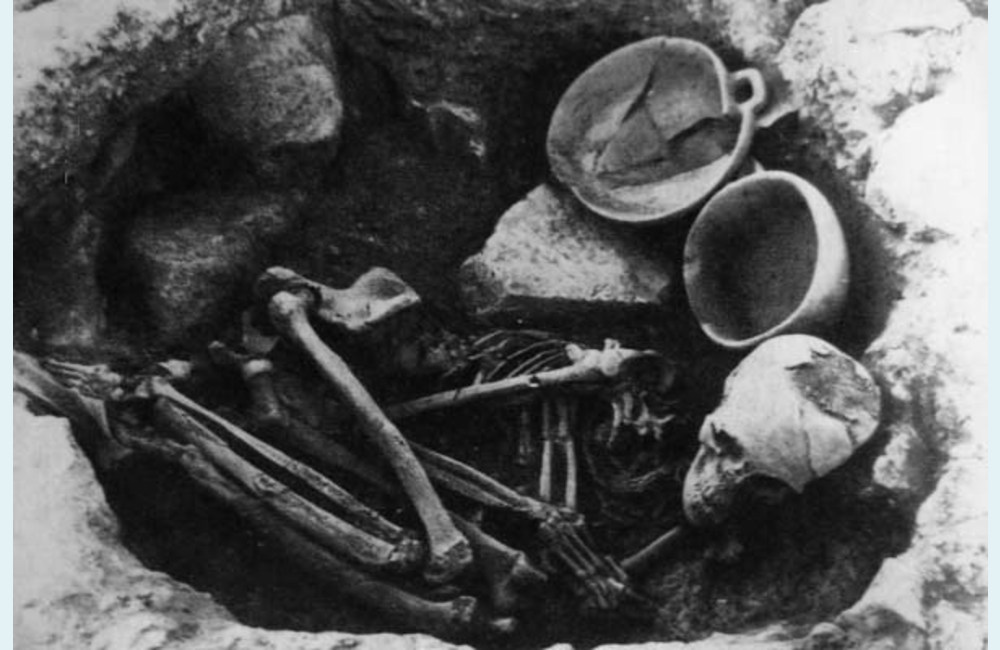The Neolithic settlement of Cyprus with circular houses and burial customs. Why did they place stones over the dead?
Choirokoitia is the best-preserved prehistoric settlement in Cyprus, dating from the later phase of the Aceramic Neolithic period (around 7000 BC).
The settlement is built on the steep slope of a hill on the western bank of the Maroni River, about 6 km from the sea.
Since 1998, the Choirokoitia settlement has been included in the UNESCO World Heritage Sites list and is located near the village of the same name in the Larnaca District.
This Neolithic settlement (7500-5200 BC) is better preserved than most settlements from the same period, not only in Cyprus but across the entire Eastern Mediterranean.
The settlement represents the successive phases of Neolithic history in Cyprus and provides invaluable information about the spread of Neolithic culture in the region.
Five houses with the characteristic cylindrical shape have been reconstructed near the settlement, using the same construction methods and materials that were used during the Neolithic period. Source of the photo: Wikipedia
How the Settlement Got Its Name
There are several theories about how the settlement got its name. One suggests it comes from the word “cheirogitia,” which refers to the practice of palmistry. Another theory proposes that it originated from the possible original name “Hierokotida,” meaning sacred space.
Others believe the name comes from the words “gyros” (circle) and “oikia” (house), due to the circular prehistoric huts discovered there.
One tradition suggests that the name comes from the phrase “Chaire Kition,” addressed by the mysterious queen of Cyprus, Rhigaina (a figure of folk tradition), to a friend from Kition.
It has also been suggested that the name could have come from the plant Anoni or Cheromolia, though this theory is considered highly unlikely.
The archaeological site of the settlement in Larnaca. Source of the photo: YouTube
The Construction of the Houses
The settlement represents one of the most impressive examples of early permanent human settlement on the island. To the west, where the settlement is not naturally fortified, a wide defensive wall was built. Its construction required collective effort, which suggests complex social organization.
The houses in Neolithic Choirokoitia were simply constructed. Stone from the river was used for the foundations and lower parts of the houses, while lighter materials such as clay and mudbricks were used for the upper parts.
The thresholds were elevated, the doorways small for flood protection, the floors made of clay, and the roofs were either domed or flat.
The roof was made of horizontal beams, over which reeds and branches were placed, covered with clay. In the center of each house, there was a hearth for cooking, lighting, and heating. It appears that the interiors of the houses were decorated with murals.
However, due to the poor condition of the murals, scholars cannot conclude whether the decorative patterns were geometric or figurative.
Burial Customs
The burial customs at the Choirokoitia settlement reveal much about the religious beliefs of its inhabitants, who showed great respect and reverence for their dead. According to the findings, the dead were buried in pits dug within the houses.
The burial pit was filled with soil and covered with a layer of clay, thus restoring the floor of the house.
The graves were individual, and the dead were buried lying on their right side, often with their body curled up (arms and legs drawn in). As scholars observe, the degree of fetal positioning depended on the age of the deceased.
The tomb is circular in shape, and special care was taken during the burial process. The majority of the deceased were placed on their side with their arms and legs bent, intact and without a fixed orientation. Source of the photo: Archaeology online
Burial goods were placed in the graves according to the deceased’s gender. Often, broken stone vessels accompanied the graves of both men and women.
Another burial custom was the placement of a stone, either unworked or carved, on the body of the deceased. This was believed to prevent the return of the dead to the world of the living.
As archaeologists conclude from the skeletons found at Choirokoitia, the inhabitants were short, with men averaging about 1.60 meters and women about 1.50 meters. They typically died between the ages of 25 and 40.
The inhabitants’ dietary needs were met through animal husbandry, hunting, agriculture, and the collection of wild fruits. The tools they used were made of stone and bone. Numerous stone vessels and figurines representing mainly human forms have also been discovered.
The Discovery
The archaeological site was discovered in 1934 by Dr. Porphyrios Dikaios, director of the Cyprus Department of Antiquities, who conducted six excavations between 1934 and 1946. His initial findings were published in the Journal of Hellenic Studies in 1934.
Further excavations took place until the early 1970s, but were interrupted by the Turkish invasion of Cyprus. A French mission, led by Alain Le Brun, conducted new excavations in 1977.
To help visitors understand the historical significance of the settlement and to protect the ancient site, the Department of Antiquities created a reconstruction of five circular houses and a defensive enclosure at the entrance to the Choirokoitia settlement.
Traditional materials and construction techniques were used for the reconstruction, and authentic Neolithic objects were placed inside the houses.












